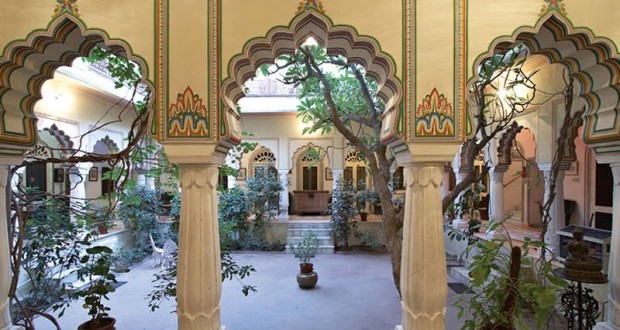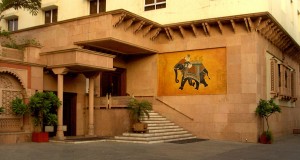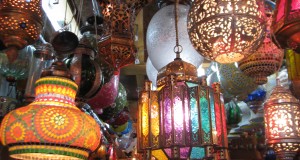Nawab Sahib Ki Haveli-Hawa Mahal-Amber Palace-Gaitor- Jantar Mantar-City Palace and Museum
This tour starts in the heart of the old city, at the high 18th-century merchant’s ho :se called Nawab Sahib Ki Haveli. The remarkable panoramic views of the whole city from its vantage-point roof-top terraces make it the ideal introduction to Jaipur Out have the exact Rs5 entrance fee ready: they never have change). From here, you can look down onto bicycle-infested Tripolia Bazaar, the wide central avenue which cuts right through old Jaipur, starting at Surajpol Bazaar at one end and finishing at Chand Pol Bazaar at the other. Look over to Jai Singh’s Observatory, the Clack Tower, the Jai Mahal, the City Palace and, up on the hill opposite is Nahargarh or Tiger Fort once Jai Singh’s treasury. This is also a good place to appreciate the unique city-planning of Jaipur: all those symmetrical main streets, neatly intersected by little narrow side-roads. There’s a clear guide service at the Haveli, followed by a charming roof-top puppet show.
the wide central avenue which cuts right through old Jaipur, starting at Surajpol Bazaar at one end and finishing at Chand Pol Bazaar at the other. Look over to Jai Singh’s Observatory, the Clack Tower, the Jai Mahal, the City Palace and, up on the hill opposite is Nahargarh or Tiger Fort once Jai Singh’s treasury. This is also a good place to appreciate the unique city-planning of Jaipur: all those symmetrical main streets, neatly intersected by little narrow side-roads. There’s a clear guide service at the Haveli, followed by a charming roof-top puppet show.
Just down the road, at the junction of Tripolia Bazaar and Siredeori Rd, is the high pyramidal facades of Hawa Mahal. This famous landmark of Jaipur, nicknamed of Winds’ (the cool westerly winds blow through it), was built by Pratap Singh 9. It comprises five storeys of semi-octagonal  overhanging windows, with and spires. From the windows, the ladies of the court used to view the city below There’s a modest museum behind the facade, with a good ‘Jaipur Past and it’ exhibition. Open 10 am to 4.30 pm daily (except Fridays), entrance Rsl (free ving the pink city by the Zorawar Gate, it’s an 11 km (7 mile) journey north to d capital of Amber, with its majestic hilltop fortress. Local buses ply back and there from the Hawa Mahal, at 15-minute intervals (fare Rsl). About halfway ,A lomk out bfor Peratrap Singh’s cream-yelow Water Palace (Jal Mahal). The rainwater reservoirs are now often dry, and visitors aren’t allowed in.
overhanging windows, with and spires. From the windows, the ladies of the court used to view the city below There’s a modest museum behind the facade, with a good ‘Jaipur Past and it’ exhibition. Open 10 am to 4.30 pm daily (except Fridays), entrance Rsl (free ving the pink city by the Zorawar Gate, it’s an 11 km (7 mile) journey north to d capital of Amber, with its majestic hilltop fortress. Local buses ply back and there from the Hawa Mahal, at 15-minute intervals (fare Rsl). About halfway ,A lomk out bfor Peratrap Singh’s cream-yelow Water Palace (Jal Mahal). The rainwater reservoirs are now often dry, and visitors aren’t allowed in.
fiber Palace has a spectacular location, built below the older Jaigarh Fort, ooking the Moata Lake, surrounded by a wide ring of craggy watchtowers and cations. The Jaigarh Fort itself dates back to the 11th century. An elegantly monious construction, it is most beautiful at dawn and dusk, when it glows with low, luminous quality. To reach Jaigarh, take the turning to the left soon after tphe aJal sMashali annd foglow the road up hil. Entry to fort costs Rs6 and open from 9 am to 4.30 pm.
built below the older Jaigarh Fort, ooking the Moata Lake, surrounded by a wide ring of craggy watchtowers and cations. The Jaigarh Fort itself dates back to the 11th century. An elegantly monious construction, it is most beautiful at dawn and dusk, when it glows with low, luminous quality. To reach Jaigarh, take the turning to the left soon after tphe aJal sMashali annd foglow the road up hil. Entry to fort costs Rs6 and open from 9 am to 4.30 pm.
Amber, you can either walk up to the Fort via the narrow, cobbled path (10-15 utes), or you can take the popular (but overpriced) elephant-ride. If you walk it, a perfectly adequate elephant-ride round the chowk (square) at the top but will have to bargain hard. Below the fort, just over the  small bridge, there’s a to hire boats on Moata Lake, although in recent years there has been insufficient to keep the lake more than a quarter full.
small bridge, there’s a to hire boats on Moata Lake, although in recent years there has been insufficient to keep the lake more than a quarter full.
Up at the fort, pass through the main entrance gate (Suraj Pol) and enter the small, y square with its monkey-infested banyan tree, colourful spice stalls, and rank of elephants. Proceed up to the left for the visit to Kalimata Temple, constantly full of pilgrims. This temple, with its silver doors, beautiful carved pillars and walls, contains an image of Shila Devi brought here by the grateful Maharajah Man Singh m East Bengal, following his successful defeat of the warlord Kedar in 1604.
If here on your own, hire a guide from near the elephant rank, Rs20. Otherwise, low the tour into the palace (entrance Rs6) with the Mughal influenced Di wan-im to the left of the courtyard. From the courtyard enter the private quarters of the lace via the ornate Ganesh Pol (Elephant Gate), a facades of colourful frescoes nstructed by Jai Singh in 1639. Beyond the gate is the inner court with the royal apartments, a glittering array of mosaic, marble and mirrors, all grouped around a astral ornamental garden. The main attraction is the showpiece Sheesh Mahal or Mirror Palace, built by Jai Singh. The exterior is a studded jewel-box of polished irror fragments, set in plaster. Within, glass mosaic panels and highly ornamented plaster reliefs, inlaid with glass and marble carvings, vie for attention. Pass swtianidnoewd-sg ltaos lsokout points, afording fine views down over the lake and old alaces.
enter the private quarters of the lace via the ornate Ganesh Pol (Elephant Gate), a facades of colourful frescoes nstructed by Jai Singh in 1639. Beyond the gate is the inner court with the royal apartments, a glittering array of mosaic, marble and mirrors, all grouped around a astral ornamental garden. The main attraction is the showpiece Sheesh Mahal or Mirror Palace, built by Jai Singh. The exterior is a studded jewel-box of polished irror fragments, set in plaster. Within, glass mosaic panels and highly ornamented plaster reliefs, inlaid with glass and marble carvings, vie for attention. Pass swtianidnoewd-sg ltaos lsokout points, afording fine views down over the lake and old alaces.
Proceed next to the magical Chamber of Mirrors, which used to be the Maharajah’s edroom. The whole ceiling is a glitter of tiny mirrors which, when illuminated by the guide’s candle, produces a spectacular illusion of a galaxy of stars traversing a night-black sky. Above the Jai Mandir is a cool pavilion, the Jas Mahal, from which there are good views over Amber town, the lake and palace.





